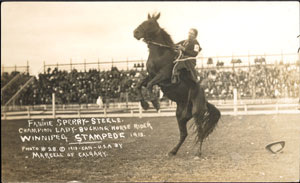Rodeo
Rodeo is a competitive sport that arose out of the working practices of cattle herding in Spain, Mexico, and later the United States, Canada, South America, Australia, and New Zealand. It involves horse riding, roping, and other skills to test the abilities of cowboys and cowgirls. Rodeo has evolved from an informal gathering of cowhands to a highly organized and professional sporting event, showcasing a unique blend of agricultural, sporting, and cultural traditions.
History[edit | edit source]
The origins of rodeo can be traced back to the ranches of the early Spanish settlers in the Americas, where vaqueros (the Spanish term for cowboys) developed techniques for rounding up, roping, and managing cattle. These skills were essential for the operation of large ranches and were passed down through generations. As cattle ranching spread into the North American west, Anglo cowboys adopted and adapted these practices. By the late 19th century, informal competitions began to emerge, pitting cowboys against each other in events that tested their working skills.
Events[edit | edit source]
Rodeo events can be divided into two main categories: timed events and rough stock events.
Timed Events[edit | edit source]
- Team Roping: Involves two riders, a "header" and a "heeler," working together to rope a steer as quickly as possible.
- Tie-Down Roping: A solo event where a cowboy ropes a calf and then dismounts to tie three of its legs together.
- Steer Wrestling: Also known as bulldogging, this event requires a cowboy to wrestle a steer to the ground by its horns.
- Barrel Racing: Primarily a women's event, where cowgirls race around a cloverleaf pattern of barrels in the fastest time.
Rough Stock Events[edit | edit source]
- Bull Riding: Riders attempt to stay mounted on a bucking bull for eight seconds, using only one hand to hold onto a rope tied around the bull.
- Saddle Bronc Riding: Contestants ride a bucking horse, using a specialized saddle, for eight seconds.
- Bareback Riding: Similar to saddle bronc riding, but without the use of a saddle, requiring the rider to hang on using a rigging that resembles a leather suitcase handle.
Culture and Controversy[edit | edit source]
Rodeo is deeply embedded in the cultural fabric of the regions where it is popular, often associated with cowboy culture, rural life, and traditional values. It is celebrated through events like rodeo parades, queen competitions, and dances, contributing to community identity and cohesion.
However, rodeo has faced criticism from animal rights groups, who argue that the events are cruel and subject animals to unnecessary stress and risk of injury. Rodeo supporters counter that modern rodeos are heavily regulated to ensure animal welfare, with strict rules governing the treatment of rodeo animals.
Governing Bodies[edit | edit source]
Several organizations govern rodeo at various levels, establishing rules, sanctioning events, and promoting the sport. The most prominent include:
- Professional Rodeo Cowboys Association (PRCA): The largest rodeo organization in the United States, sanctioning over 600 rodeos annually.
- Women's Professional Rodeo Association (WPRA): Focuses on women's events, particularly barrel racing.
- International Professional Rodeo Association (IPRA): Sanctions rodeos in the United States and Canada.
In Popular Culture[edit | edit source]
Rodeo has been depicted in movies, music, and literature, often romanticizing the cowboy lifestyle while also exploring the challenges and dangers of the sport. It remains a symbol of Western heritage, celebrated in art and folklore.
See Also[edit | edit source]
Search WikiMD
Ad.Tired of being Overweight? Try W8MD's physician weight loss program.
Semaglutide (Ozempic / Wegovy and Tirzepatide (Mounjaro / Zepbound) available.
Advertise on WikiMD
|
WikiMD's Wellness Encyclopedia |
| Let Food Be Thy Medicine Medicine Thy Food - Hippocrates |
Translate this page: - East Asian
中文,
日本,
한국어,
South Asian
हिन्दी,
தமிழ்,
తెలుగు,
Urdu,
ಕನ್ನಡ,
Southeast Asian
Indonesian,
Vietnamese,
Thai,
မြန်မာဘာသာ,
বাংলা
European
español,
Deutsch,
français,
Greek,
português do Brasil,
polski,
română,
русский,
Nederlands,
norsk,
svenska,
suomi,
Italian
Middle Eastern & African
عربى,
Turkish,
Persian,
Hebrew,
Afrikaans,
isiZulu,
Kiswahili,
Other
Bulgarian,
Hungarian,
Czech,
Swedish,
മലയാളം,
मराठी,
ਪੰਜਾਬੀ,
ગુજરાતી,
Portuguese,
Ukrainian
Medical Disclaimer: WikiMD is not a substitute for professional medical advice. The information on WikiMD is provided as an information resource only, may be incorrect, outdated or misleading, and is not to be used or relied on for any diagnostic or treatment purposes. Please consult your health care provider before making any healthcare decisions or for guidance about a specific medical condition. WikiMD expressly disclaims responsibility, and shall have no liability, for any damages, loss, injury, or liability whatsoever suffered as a result of your reliance on the information contained in this site. By visiting this site you agree to the foregoing terms and conditions, which may from time to time be changed or supplemented by WikiMD. If you do not agree to the foregoing terms and conditions, you should not enter or use this site. See full disclaimer.
Credits:Most images are courtesy of Wikimedia commons, and templates, categories Wikipedia, licensed under CC BY SA or similar.
Contributors: Prab R. Tumpati, MD



